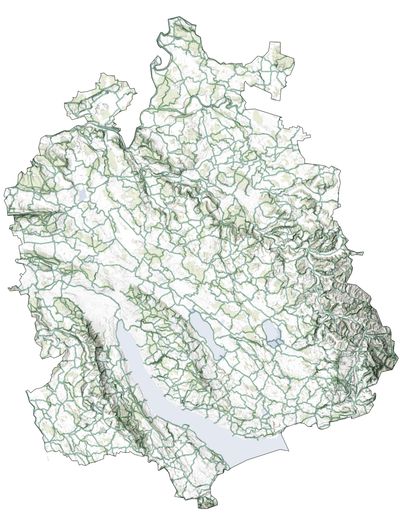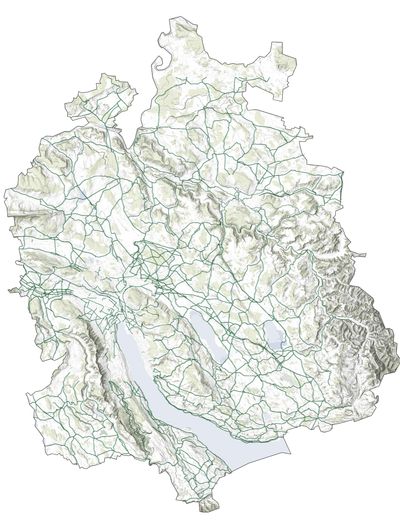AtlasHealth, Culture, and RecreationLaura Pfeiffer and Selin Civi
When it comes to the topic of health, culture and recreation it can be said that Switzerland has a reputation for offering a high quality of life to its citizens. This can be seen in studies like the Better Life Index, where Switzerland ranks 3rd. To analyse the different influencing factors the Canton of Zurich can be looked at as a case study. The topic of Health, Culture and Recreation has different subcategories but can generally be divided into two groups: on one hand there is the coverage of basic medical needs, which contains health and elderly care and on the other hand different recreational infrastructures like hiking trails, bike routes and cultural centres. The distribution of facilities and services for the coverage of basic medical needs display the image of a polycentric city with the City of Zurich as a centre and other important subcentres such as Winterthur, Bülach, Uster and Wetzikon. This network of subcenters is evenly distributed throughout the canton. The recreational infrastructures, in contrast, has an appearance of its own and do not quite fit into the pattern of the different subcentres. The distribution is less balanced and in the rural areas the cultural recreational offer is rather not so present. Here there seem to be two centres, where everything is concentrated: on the one hand the City of Zurich and on the other hand Winterthur. It becomes visible that the lack of supply in rural areas is compensated mainly by the presence of the natural environment.

Polycentric Zurich. Source: Laura Pfeiffer and Selin Civi
Swiss Life = Good Life?

Better Life Index Rating. Sources: OECD

Better Life Index Factors. Sources: OECD
The Better Life Index is a still ongoing study that compares well-being in different countries based on 11 topics connected to material living conditions and quality of life. Switzerland ranks 3rd in the Better Life Index, which indicates a high level of satisfaction among the population. The results of the 11 topics seem all more or less balanced, except for the Civic Engagement category. Based on the categories of Health, Community, Work-Life Balance and Life Satisfaction, it can be said, that Switzerland’s government attaches great importance to the health of its citizens and the population also values social networks and a wide range of leisure activities in addition to work, which contributes greatly to their satisfaction and mental health. For a better understanding, Zurich can be taken as an example to have a better look at the 4 categories Health, Community, Work-Life Balance and Life Satisfaction.
A Centralised Pattern of Medical Care

Doctors per 1’000 inhabitants. Source: Opendata Swiss
- 5.7 doctors
- 3.0 doctors
- 2.0 doctors
- 0.2 doctors
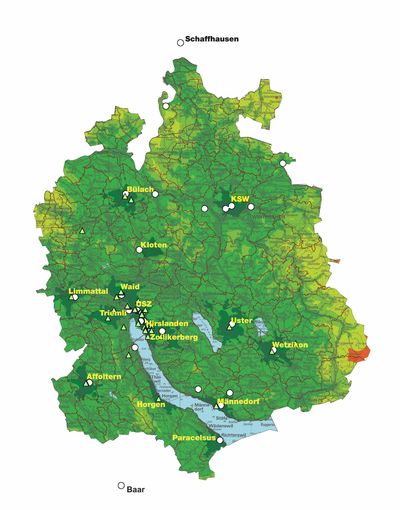
Accessibility of basic medical care. Source: Spitalplanung Kanton Zürich
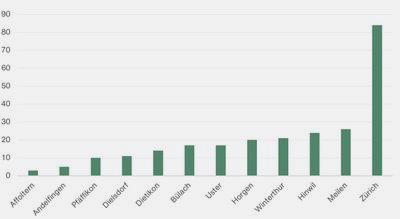

Number of hospital beds per 1’000 inhabitant over the age of 65. Source: Spitalplanung Kanton Zürich
- 104 hospital beds
- 56 hospital beds
- 31 hospital beds
The distribution of health care infrastructure shows a certain pattern in the Canton of Zurich. This pattern is represented the clearest in the category of density of doctors per 1’000 inhabitants by communes. In the area of the city centre of Zurich the density is quite high. However, it can be observed that there are certain subcentres such as Winterthur, Bülach, Uster and Wetzikon, which also offer a significantly higher density of doctors compared to the remaining areas.
When it comes to the basic medical care in the Canton of Zurich (does not include psychiatries, rehabilitation, special treatment centres) it might appear to be more or less equally. Approximately 97% of the inhabitants of the Canton of Zurich reach the nearest hospital within 15 minutes driving distance. However, an accumulation in the area of the City of Zurich is visible. Additionally, the image of the subcentres can be read in the location of hospitals. Similar to hospitals the psychiatries, represented here with triangles, follow in their density the pattern of centres and subcentres. About one third of the patients are treated by the Psychiatric University Hospital Zürich while the psychiatric ward in Winterthur treats approximately one fifth of all patients in the canton. So these two wards handle more than 50% of the psychiatric patients. The hospitals, represented by a circle, show clear irregularities in their distribution across the canton with a strong concentration in the centres.
Elderly care can be measured by the number of hospital beds per 1000 elderly inhabitants (over the age of 65). In 2020 Zurich counted 17’810 hospital beds in 257 care centres total across the Canton. The hospital beds, however, are not equally distributed between the different districts; the district of the City of Zürich provides the highest density of elderly care with total of 104 beds, followed by the districts Hinwil and Meilen. The districts of Dielsdorf and Affoltern have the lowest number of beds for their elderly population.
Countryside as Recreational Landscape

Parks and sport facilities. Source: Swisstopo

Parks and sport facilities in Oerlikon. Source: Swisstopo
- forest
- public recreation
- sport facilities

Parks and sport facilities in Otelfingen. Source: Swisstopo
- forest
- agriculture
- sport facilities
Switzerland seems to be a very sporty country. Sports take up a large part of leisure activities in Switzerland, especially hiking is very common and forms part of the swiss culture. Around four million Swiss people aged 15 and over hike regularly, which is more than half of Switzerland’s population. Hiking has also recorded the highest increase of all sports. What is striking about the distribution of hiking trails is that, for obvious reasons, there are fewer trails in urban areas than in the rural parts and especially in mountainous regions. In contrast, the distribution of bicycle paths is rather balanced and there are also many bicycle paths in urban areas. Thus, the category of recreation does not fit into the pattern of the polycentric network but rather has an appearance of its own.
Another important recreational space are parks as they serve as gathering places in many cities and can host various activities. These parks are often attached to sports facilities because many of them are also used for sports. A high density of recreational spaces can be observed in different urban areas, as there are not many natural resources that cities can provide for its population. Lakes also significantly influence the location of publicly accessible parks; these recreational spaces are especially prevalent along lake shores. When comparing Oerlikon, part of the City of Zurich, and Otelfingen, a rural area which is per definition labelled as a village, some crucial differences in terms of recreational facilities can be mapped. As the formerly industrial area of Oerlikon was redeveloped and densified it shows several green spaces and parks that were part of this development such as the Oerliker Park which was finished in 2001. Whereas in Otelfingen, in contrast to Oerlikon, parks are rather uncommon. The nearby green spaces and forests serve here as recreational places as well as the surrounding land, which is used for agriculture.
Churches as Cultural Centres in the Countryside

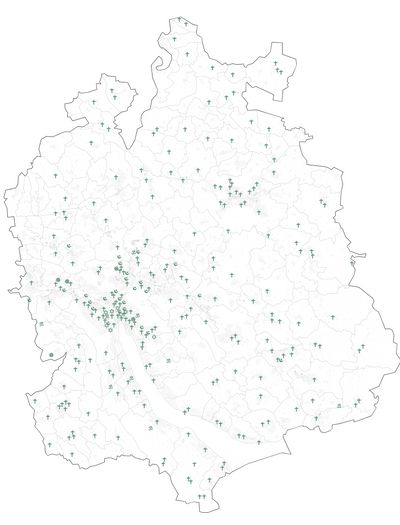

Even if leisure is equally important for the quality of life and health as well as health care, cultural activities, in contrast to health care facilities, tend to be less well distributed in the canton of Zurich and are almost all centred in the city of Zurich. The only subcentre that emerges next to the city of Zurich is Winterthur. As can be seen, religious buildings with church services serve as meeting places mainly in the smaller villages, where the cultural facilities are fewer or even non-existent.
